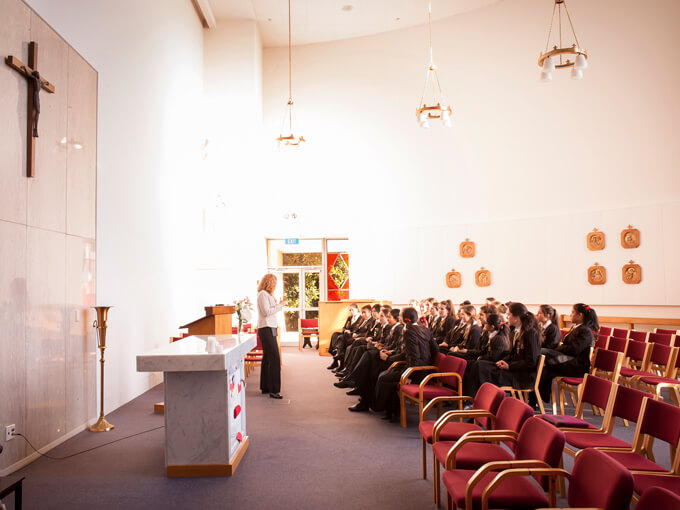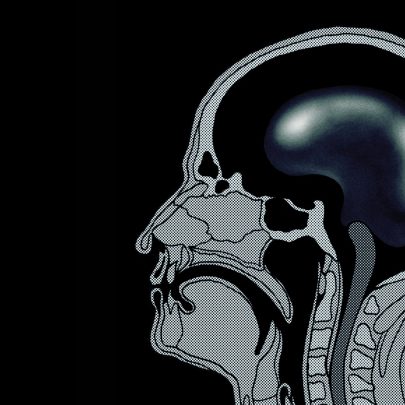Dec 19, 2019 Schools
From the Metro archives: Aimee Cronin writes in 2015 that Catholic schools are the big success story in Auckland education – a trend which continues in 2019. Why is that? And how good are they really?
Theresa Saolotoga’s phone makes the sound of a chicken and she wakes at 6.30am. She rolls a lightweight arm out of bed and pushes snooze. She’s tired from reading late, even though it’s a school night. On a small side table sit some of her favourite things: a lamp, The Color Purple, rosary beads and a Bible. Theresa, named after the saint, tries to read one passage of scripture a night.
There are two things hanging in her room. She would have more, only her mum doesn’t want to risk marking the walls of the four-bedroomed home they rent in South Auckland for $600 a week. Theresa has a large poster that says, “Stop wishing, start doing”, and a crucifix above her window. If she could add one thing, it would be fairy lights. Her McAuley High School uniform is hanging in the closet and she changes into it first thing. When it was announced she would be deputy head girl this year, her mum, Leemo, could hardly believe it. Theresa said: “Mum, you don’t know me at school.”
At home, the most noise she makes comes from the piano; she plays in the hallway and the house fills with the sweet sound of music.
At home, religion is underlined by the presence of a dozen statues. The biggest is of Mother Mary, standing in the prayer corner of the lounge, where the family gather each night.
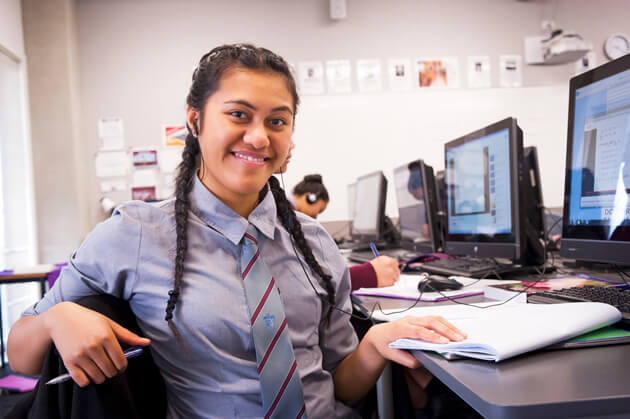
Leemo’s prayers start with the rosary when she wakes at 5am. Older sister Lette has left for work before Theresa stirs to the sound of chickens. At the moment, Lette is the only member of the family with a job. It’s Leemo’s idea that her two youngest children pray in the van on the way to school. Otherwise she would worry they have forgotten. Faith, she says, is the centre of their lives.
Little brother Louis starts. He thanks God for waking his family up to live another day. He thanks God for giving his dad another heart so that he could live. He asks God to guide his family through the day. Theresa prays next. She thanks God for his creations. For the gift of life, for her talents, for everything God has done throughout her hardships. She thanks him for his protection through the night as she slept. She asks him to give her family strength, knowledge and happiness. She asks him to be with all the families who are going through hard times and have lost a loved one. She asks him to accept the poor souls in purgatory into his kingdom. She says, “Lord, hear us,” and her mother and her brother reply, “Lord, hear our prayer.”
READ MORE: The best schools in Auckland 2019?
They say the Our Father, 10 Hail Marys, the Divine Mercy Eternal Prayer, the Litany of Saints, all in English, then they say the Hail Holy Queen in Samoan — Si o’u alofa Lesina, le Tina ole agaalofa, o oe, lo matou ola, lo matou fiafia ma lo matou fa’amoemoe, si o’u alofa — and then they finish. By 8.20am, Theresa is through the McAuley gates.
The day at McAuley High School starts and ends with prayer. Faith exists here, indeed, but Catholicism travels with McAuley girls. Life is church, family, school. After school, it’s church, family, work. The church part stays. Principal Anne Miles, this year made a member of the New Zealand Order of Merit for services to education, says that’s one reason the school shines next to others on achievement tables and does even better when it’s compared with others with the same 1B decile rating. It’s one reason. A third of the girls who start here are below average in literacy and numeracy by at least two years. About 7 per cent are up to four years below. They don’t tend to stay that way for long. Last year’s NCEA level 1 results declare a 99 per cent pass rate in numeracy and a 100 per cent pass rate in literacy. “I’m only concerned that the girls achieve to the maximum of their potential,” says Miles, “and I’d be horrified if we achieved below the national average. That would disappoint me, because I believe they can, and the girls now believe they can, and that’s what really matters.”
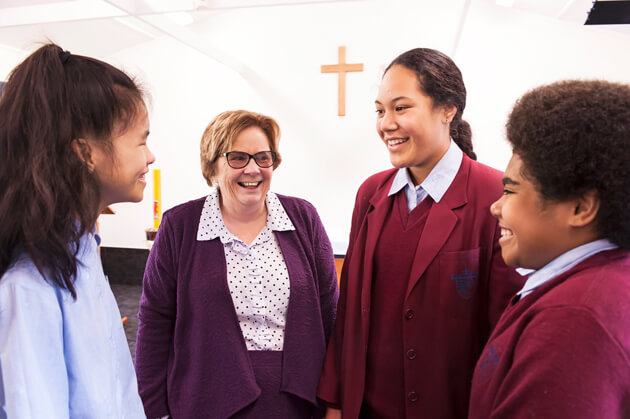
She handpicks 10 of the best students to sit around a shiny table in a small meeting room and talk about the McAuley magic. Paulina Tapuai-Soti puts her hand up: “Most of our inspiration comes from our backgrounds. It’s about what we want to achieve not only for ourselves, but for our family that gets us where we are now.” Ask who goes to church every Sunday and up go 10 hands. “God plays a big part in all our lives,” says one, and they all agree. Who has a parent who went to university? Up go five hands. “Do aunties count?” one says, and they all laugh. Each one of them plans to. Ask who would like to live in South Auckland after study? Up go 10 hands. “This is our home,” one says. And they all agree.
It’s a five-minute walk from the main street of Otahuhu to McAuley High School. They say you can hear the girls coming at the end of the school day after stopping at Prize Catch for a feed of $1 chips. In school time, none of them can be spotted wagging on Great South Rd, none seen in the window of Carl’s Jr. or Burger King, or any of the fast-food outlets that stand their ground in this poor town. They say there are more than 100 booze shops in the Otahuhu/Mangere area. There are issues, all right. The only young girls to be seen before school’s out are the ones pushing prams, and they have sad faces like returned soldiers drinking at the local during the day.
Apparently, the biggest threat you can give a McAuley girl is expulsion. Where would she go? The girls at this school know what option B looks like. “Our community has got poorer,” says deputy principal Kiri Turketo. “I tell no lie when I say we have families who have only one person working on minimum wage and they’ve got eight people in the house.“
These girls have chosen education to be their chance at a better life. Their parents say, ‘Have the life we haven’t got at the moment, and the only way you can do that is by having an education because it gives you choices.
’”These are the things that Turketo believes make McAuley what it is: “Every single person cares. What I mean is that from the cleaners, to the caretakers, to the parents, to the students and staff, every single person rolls up their sleeves and gets on with it.” The school encompasses the values of the Pasifika families who make up 83 per cent of the roll: “The girls come from very robust, faith-based families. We go to church, we have Mass here, we walk the road of faith and the girls and their families walk it as well.” Catholic schools perform. They sit well above national averages across all levels of NCEA. In Auckland, 75.6 per cent of students leaving Catholic schools attained University Entrance in 2013, as opposed to 52.5 per cent from state schools. About 45 per cent of Catholic-school students in Auckland are Pakeha, and that percentage is dropping. Pacific Island students make up 28 per cent.
In state schools, Pasifika students can be a gloomy statistic, but their numbers grow at Catholic schools and achievement grows with them. When Anne Miles arrived at McAuley 12 years ago, she started handing out achievement certificates at school assemblies, but to begin with, it wasn’t cool to win them. “Shame!” the girls would say. When pass rates began to accelerate, she scheduled an academic assembly to start each school year so the girls knew achievement was the new normal. “It’s good,” says a Year 13 girl. “It motivates us, it helps us get through. You don’t want to be the year level that made it drop.” Miles outlawed fighting, in or out of school. “It took one year and they [the fights] all disappeared. There are high expectations of behaviour here.” It would be obvious, and probably correct, to attribute the change in culture to Miles. In the early days, she would tap on the car windows of parents who dropped their girls off late, wanting to know why. “Because,” they would say, “we drop our son off first. He is more important.” “Oh no,” she would say, “your daughter is more important.”
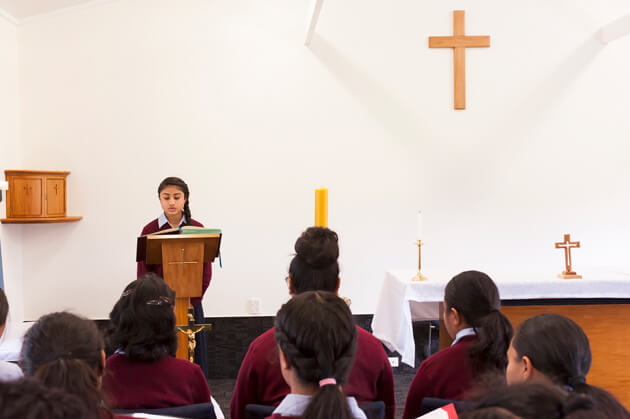
Nothing matters more than the girls inside her gates. She’s a funny sort of woman. There’s nothing fancy about her. She appears to be both shrewd and dithery. Teachers tell stories about her arriving at school wearing two different shoes after getting dressed in the dark, and not being in the least bit bothered. They laugh about her messy handwriting, how she sometimes forgets her lunch. Then, she will be serious and shrewd. She knows who is passing and failing. Who needs lunch, who needs a new uniform. If she sees litter on school grounds, she picks through security cameras to find who dropped it.She approached the local Warehouse about donating laptops to the school and when they asked how many, she said 800. One for every girl. “People laughed at me, but we got 90, and I think other schools got 30.” She arrived at the Remuera Golf Club and petitioned members to donate money so she could buy uniforms for the poorest of her girls. They signed a cheque for $5000. “The girls know that I will do anything for them,” she says, “that I will protect them.”
There are signs of success everywhere at this school. At lunchtime, the library is full. A thousand more books a year are being loaned out than in the past. There’s excitement about the latest teen fiction: 16 reserves on Love, Rosie . Theresa Saolotoga has her name down for it. The computer labs are full, Samoan cultural practice is full, street dance practice is full, and the place is loud. Digital media technology teacher Mike Hancock has worked in other schools, “where every kid had their head down in their phones — it was so quiet. It’s great here. It’s noisy. These kids know how to play.”
Less than 15km up the road in a classroom at Baradene College of the Sacred Heart in Remuera, 25 student ambassadors sit in a classroom and talk about their school. Ask them who goes to church every Sunday and they laugh and look around. Up go five hands. Ask who has a parent who went to university and up go 21 hands. Ask who has views that would go against the Catholic Church’s teachings — up go 22 hands. Ask what makes the school achieve so well and one girl says, “There’s emphasis on young women to change the world,” and the whole class erupts into spontaneous clapping.
This is a place full of ponytails and red ribbons, where visitors walk up grand steps and look out over grounds even a Lotto win couldn’t buy. Cor Unum! One heart, one mind in the heart of Jesus Christ! It’s a creed principal Sandy Pasley says the girls sing out a lot. At Baradene, Sister Philippa Wittering makes her way down from the nuns’ quarters every morning and opens the mail. This year on her birthday, students lined the corridor and sang to her as she shuffled along to the mailbox and back. At Baradene, caramel slice is a favourite at the canteen, the most common uniform misdemeanour is wearing a top button undone or the wrong coloured hair tie, it’s uncool to have a short skirt, it’s cool to say “Later Bo!” and short hair is as unusual as it gets. On the wall in a junior classroom, students write their first impressions of the school: “Loud house leaders cheering cheerfully; old, wooden stairs creaking noisily; clean, expensive, pretty white uniforms; powerful teachers walking and talking.”
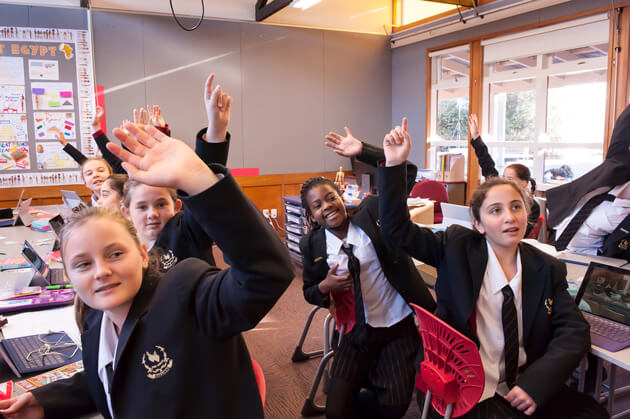
They call themselves Bara Girls, but are known on the street by other school kids as Baradogs. “It’s because we’re the poorest of the rich schools,” one girl says. “We own it,” says another, “we sing ‘Who Let the Dogs Out’.” (McAuley gets Bull Dogs, and, says one student, “people from other schools throw rocks at the bus and bark when we go past”. No names, they can think of, for the boys’ schools). At Baradene, more than 7000 books have been issued at the school library since the start of the year and the most popular is The Boy in the Striped Pyjamas. Students bring their own electronic devices and girls who forget can get one from the library. One Year 7 with a long ponytail and a red ribbon has a laptop case that reads: “Shoes make me happy. I’m superficial. Whatever.”
NCEA pass rates at Baradene are in the nineties across all levels. That’s how it goes. Most girls start here in Year 7, where the primary school model is ditched for a school-wide curriculum and specialist teachers. The youngest of the girls are taught about the history of the school when they arrive. “We look for their grannies in the magazines,” says dean Carol Adamson. “I tell them, ‘Someone will come looking for you one day, so let’s leave them something good to find.’”Baradene has a private-school vibe. Pasley thinks this is because it’s in Remuera. That has something to do with it.
It is state integrated and zoned, so it must take Catholics from the area. The selection process is similar to McAuley’s, but the big difference is that it costs $23,116 to go to Baradene for the five years to Year 13 and $3960 to go to McAuley. St Peter’s College in Epsom costs $15,820 over that period. All three schools have waiting lists.
Pressure to perform at McAuley is often about being the first one in the family to succeed at something academic, and pressure to perform at Baradene is about not being the first in the family to fail. Pasley says the religious nature of the school helps girls to face that pressure and it makes them more resilient. “If you have a strong faith, you can withstand the knocks that life gives you.” She says that although the girls leave Baradene with an “anything’s possible” attitude, the special character of the school has inspired many of them to go down pathways that give something back, as opposed to just chasing money. Special character can be spotted a lot here, she says. “The girls and their families are incredibly generous.” Translation: they donate money. There are social awareness programmes, too, where the girls do community service, and the ones looking for a leadership role have to be able to show they do community service in their own time. All Catholic-school students study religious education, but Pasley says, “It’s not just one subject — it’s in everything they do here at the college.”
Pasley is a staunch advocate for the faith. She came to Baradene four years ago from St Mary’s, where she established a similar record of outstanding achievement, and it seems unimaginable that she or anyone else at the school would want to shake up the religious culture and traditions. She has a Baradene quality that fits. She talks in a refined way, with an expression on her face that is difficult to read. A mixture of warmth and reserve. She says she can be scary, “but I don’t have to be, really, honestly I don’t. A little bit of chatter at assembly and I’ll just stand there and the girls are quiet.” As a student, Pasley attended Teschemakers, a single-sex boarding school south of Oamaru. She went back and was married in the chapel there and 30 nuns attended the wedding ceremony. She has a fondness for the 10 nuns who live in the convent at Baradene now. She says the girls are lucky to have them. “They are quite amazing, liberal, out-there sisters. One regularly gives me updates from Amnesty International.” All of the sisters have retired from teaching.
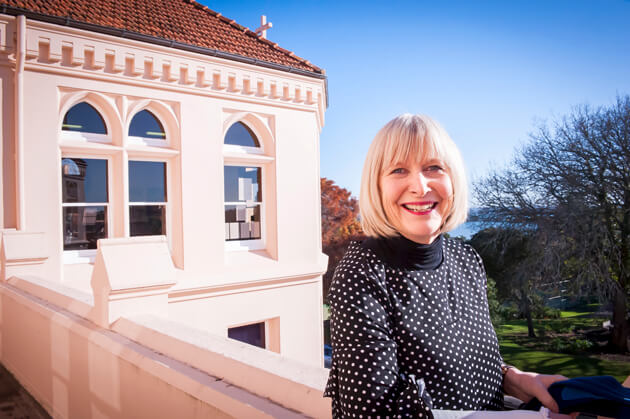
Nuns, brothers and priests were the principal educators in the old Catholic-school system, back in the day. They weren’t paid or trained, though many taught all day and studied at night. Very little help was given to non-secular education post the 1877 Education Act and Catholic schools relied on donations. New Zealand Catholic Education Office chief executive Patrick Lynch says lack of funds were to blame for poor results in those years.
It’s not uncommon to hear about the fierce discipline from the nuns and brothers, the fires of hell and all that, but Lynch says all schools had harsh teaching practices in the days of corporal punishment and dismisses the idea that improvements in Catholic schools are the result of the infiltration of trained teachers. He says the Private Schools Conditional Integration Act 1975 was what really made the difference. It increased resources dramatically and “brought Catholic schools out of the cold and into the mainstream education system”. The Catholic model, he says, is holistic and committed to excellence “and that is at the heart of the Gospel”.
It’s yard assembly at St Peter’s College. Every school day, every boy lines up in his home-room group and faces the front in a manner more casual than military, though trying it on would never end well. Teachers patrol and say one of two things: socks up, or tuck your shirt in. Assembly begins with the sign of the cross, then a prayer reading, then the college prayer: “Lord, we dedicate ourselves to you. May we give witness of your care and concern for each other, recognising you in ourselves and others…”
A small brown envelope is passed along and the occasional chink of a coin sounds as good boys suppress the urge to pocket it for the canteen. Money from these “missions”, as they’re called, is saved up and donated to charity. Last year they made $20,000, which went to a refuge centre. The notices are read and there are plenty of them: trees for survival, Young Vinnies (junior members of the St Vincent de Paul Society charity), football, debate, lawn bowls, rugby, basketball, jazz band, orchestra, and on and on. Then a reflection, a prayer, a mention of each student whose birthday is today, and a word to cowboys seen jumping on the train tracks after school: “That, gentlemen, is a death waiting to happen. I’ll put it plainly: we wait quietly and patiently for the train.” To the left of this gathering stands a $6 million building that’s just gone up, full of modern learning environments, where the hallways are as draughty as hell. Round the back, Auckland traffic drama can be seen from the corridors of the old classrooms. The college is surrounded by 21st-century city life but, here in the yard, it feels old school. Behind the boys, a crusty prefab doubles as the school’s chapel. Around 30 students attend optional lunchtime Mass, putting up with the occasional ball slamming into the walls.
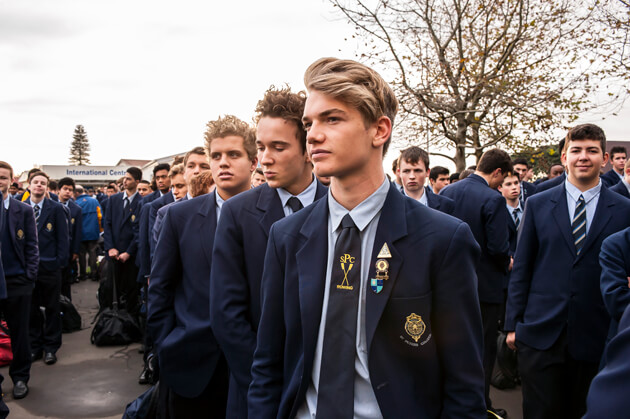
Evidence of school faith is painted on school walls: “Whoever wants to be first must place himself last and be servant of all.” And: “I will show you my faith by my works,” and so on. There are posters tacked to the main doors saying, “Littering says a lot about us. That makes it our problem,” and it doesn’t look like it’s working very well.
When they are together at interval and lunch, there’s a feeling no space would be big enough to hold these boys. They all seem to be taking part in something. Kids who like school tend to talk about brotherhoods and sisterhoods as though it’s something unique to them. It’s not. But at St Peter’s, there’s an energy to it. “The brotherhood is something you can’t describe,” says deputy head boy Craig Fernandez, “you have to experience it.” At a lunchtime special-character meeting, about 25 students are leaning on each other in an effort to illustrate something about reciprocity. The room has the hip-ray, hip-ray, hip-ray of the huddle after a rugby match. “What did we learn?” shouts one. A boy puts his hand up: “If a brother falls down, all of us fall down.” And the whole group explodes into spontaneous clapping.
Kieran Fouhy has been headmaster here for 26 years. He’s on sabbatical and associate headmaster James Bentley has stepped up. He coaches the 2nd XV, and as he does the rounds, he tells boys either “Pull your socks up” or “Good win on the weekend.” He believes the trick is to keep them busy. Every conceivable sport is offered here and framed pictures in the gym tell of the boys who have earned the prestigious sporting tie. Bentley will tell you about the ones who have gone on to wear The Jersey. “But it’s not just sport,” says middle school director Mike Mullin. “We’ve got boys across the whole spectrum. If it’s not sport, we’ll find something.” The school has a good reputation for its music programme and head of faculty Antun Poljanich says it’s connected to the special character of the school. “We are involved in all the community events that relate to Catholic character, so that boys can see the relationship between music and faith.”
St Peter’s offers Cambridge International Examinations and NCEA to its students. Its pass rates are very good: 79 per cent of all student leavers have UE, and in last year’s Cambridge A levels the pass rate was 100 per cent. Being Catholic does not guarantee a place here. This school does not take, it selects. It averages about three times as many applications as available placements. The school operates under the philosophies of the Edmund Rice traditions, one of which is inclusiveness, and another, says Bentley, is “to educate the poor and neglected”.
“We have multi-multi-millionaires’ sons sitting next to factory workers from Otahuhu’s sons. Education here is very grounding.”
How do they choose? A boy is accepted at St Peter’s for a number of reasons, says Bentley, and yes, one of them might be that he is good at rugby. “We want boys to be involved in music, sport, languages. Their academic record is important, but it’s not the most important.” He says it’s also essential that parents are committed to supporting their sons. Which does imply that state schools have the job of educating the neglected children.
Bentley says the faith of a “St Peter’s Man” deepens while he’s at the college. But that’s not always the case. For some boys entering St Peter’s, life is already church, family, school. After they leave school, it’s church, family, work. Faith is the centre of their lives.
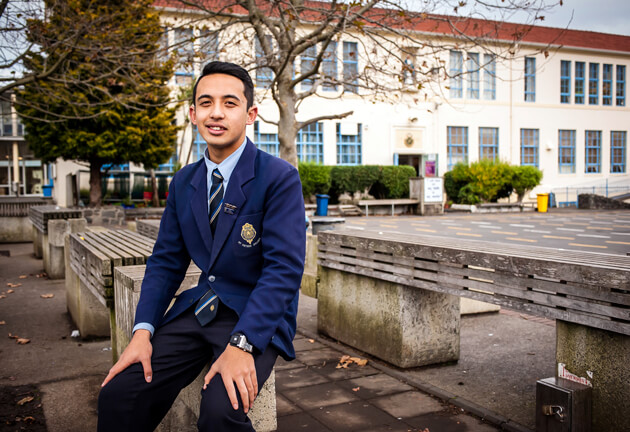
The most prominent statue in the Mangere house Christopher Oleva-Tanuvasa shares with his grandmother, father and four siblings is Mother Mary standing in the centre of the lounge, where the family gather each night to pray. Si o’u alofa Lesina, le Tina ole agaalofa, o oe, lo matou ola, lo matou fiafia ma lo matou fa’amoemoe, si o’u alofa. Christopher’s first prayer for the day takes place when he wakes. He decides in the spirit of the moment if he wants to say it out loud. He prays for his mother in Samoa, running the family shop. He praises God. He asks God to bless him for the whole day. He asks God to make the plans he has made succeed. He gives thanks. His St Peter’s College blazer is hanging in the closet and his uniform is folded away in drawers. He read somewhere that it pays to be tidy. He changes into it. When it was announced he would be head boy this year, his family said, “Glory to God!” then sat him down and told him what he needed to do. On a table in his room sit some of his favourite things: a crucifix, a Bible and the book he’s reading for school, Origins of the Cold War. Christopher has inspirational quotes hanging on the wall. He has hand-written one and stuck it above his desk.
It says, “What we are is what we repeatedly do, therefore excellence is not an act, but a habit.” If he has time before school, he will listen to his favourite Peace Chapel music, to the song “Ua E Manumalo”. Translated loosely, it means: “You are blessed.”
This piece originally appeared in the July/August 2015 issue of Metro magazine, with the headline ”In God’s name’.

